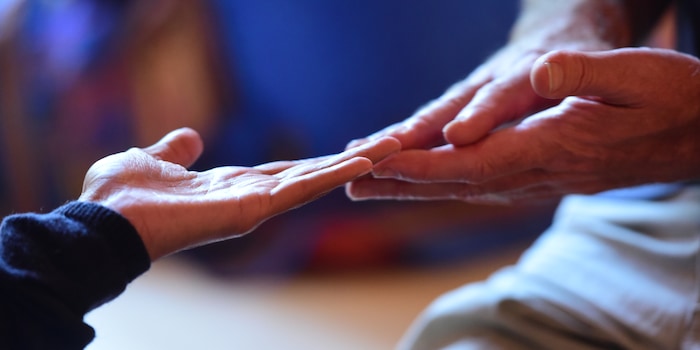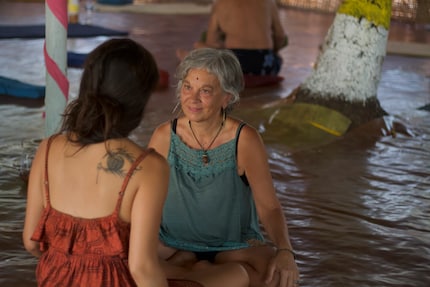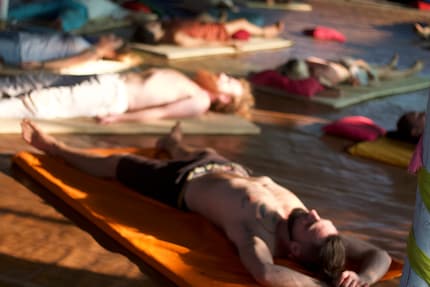
Background information
«Tantra is about love, not sex»
by Natalie Hemengül

There’s much more to this Indian philosophy than sex. Tantra teacher Mahara McKay shows us which simple exercises create true intimacy in your partnership.
My last article was all about the question what Tantra is. As multi-faceted as life itself, this subject is difficult to grasp. Nevertheless – or for this very reason – it’s worth trying it for yourself, as Tantra teacher Mahara McKay says. The 39-year-old currently lives in Goa and has been teaching oneness through Tantric private sessions and group workshops for years. She also teaches in Switzerland. «Workshop participants learn how to develop a sense of togetherness with complete strangers within a few days. This is the most motivating aspect of my work and probably the one that changes people's lives the most,» Mahara explains. Want to experience this at home with your partner? Here are some beginner-friendly partner exercises.
Eye gazing
Eye gazing is one of the most famous and easiest Tantra exercises. «It teaches us how little attention we usually pay to the other. Although we spend a lot of time with our loved ones, we rarely connect by looking deeply into their eyes,» Mahara says.
Grab a partner, be it your significant other, mother, father, friend, brother or anyone else. Sit opposite each other and lock gazes. Focus on one eye only. Left or right, whichever you prefer. You can't look into both at the same time anyway. Now try to keep looking at this eye. This makes most people feel nervous, anxious or insecure. «Although you’re literally keeping an eye on the person opposite you, the essence of this exercise is to observe yourself more closely,» Mahara says.
What are you thinking about? Are you judging the person opposite you? Can you open up to them? Are you trying to read something into them or even influence them? Are you able to just stay like that without thinking about anything? If not, ask yourself what's stopping you. Is it fear? And if so, what are you afraid of? Is there anything you can do to counteract this fear? Try not to direct your thoughts to the person opposite you, but to yourself. Pay attention to your body language: are you relaxed or are your shoulders and belly tense? Are you fidgeting with your fingers? If so, try to relax any body parts that are tense. Then focus on your breath: are you breathing shallow into your chest or deep into your stomach? Slow down each breath. This automatically makes your mind slow down.
If you don’t know your counterpart well or not at all, physical and mental side effects usually stand out more. If you’re doing this exercise with someone you know well, you’ll see that person in a new light. «This exercise is most effective if you do it with someone who makes you slightly insecure,» Mahara explains. The longer you do this, the better. If you like, you can do this exercise for up to forty minutes. But five minutes is enough to start off. What’s exciting is that you’ll feel different with every exercise partner. It also works via video call, by the way.

Listening
Do this exercise with someone you’re close to. During one week, share two to five things you like or appreciate about each other every day. Turn it into a ritual that always takes place in the evening before dinner or before you go to bed. Here’s an example of what you might say: «I really appreciated that you did the dishes today.» Or, «I appreciated the way you smiled at me and wished me a good morning.» Think of profound, funny, simple or crazy things to tell the other. What’s important is that you don't start a discussion. This exercise is about truly listening to what the other person is saying and then switching roles. «This ritual shows your appreciation for each other. In everyday life, we easily forget to appreciate each other and start taking things for granted. In fact, it's best to make this exercise an integral part of your daily routine together,» Mahara adds.
Every five minutes
«If I asked you which part of the sole of your foot touches the ground first when you walk, you probably don’t know the answer,» Mahara says. «That's because we walk at a high pace and don't pay attention to little things. We’re not aware of what’s going on inside us and how our body moves or behaves. No matter what we’re doing, high speed gets in the way of our mindfulness. If we do things more slowly, we relax and notice more.»
The third Tantra exercise is based on this concept. It’s for you and your loved one. Set several alarm clocks on a smartphone that ring at five-minute intervals. View this as a kind of game. You take turns in deciding what you want to do during the next five minutes. Be creative. Mahara recommends to start the first five minutes with the eye gazing exercise to arrive in the moment. After that, you’re free to decide. Make sure to do everything slowly and consciously. As an example, gently touch your partner's face for five minutes, as if you wanted to trace all the contours. Or ask your partner to touch you very softly all over your body. The other person only feels and receives. You could also kiss for five minutes and do nothing else. Enjoy giving as well as receiving and always observe your thoughts. How does it feel? Are you totally present or are you thinking about work or the kids?

If you like, take two or three minutes after each exercise to tell each other how you felt. What did and didn’t you like? One person talks while the other one listens. Then switch roles. Don’t feel offended if your exercise partner didn’t enjoy something. Instead, ask what you can do differently next time – but only when the other person has finished talking. Unfortunately, interrupting someone unintentionally can easily happen. «This is an insight into conscious sexuality. It’s about finding out what relaxes you, slows you down and what makes you feel comfortable and able to open up in that very moment. All without being afraid to share your honest opinion. These conscious touches help you get to know yourself and your body as well as your partner better. It’s not about taking something from the other person, but about recognising how much joy there is in giving and how important physical closeness is for humans. We often forget that everybody is different and therefore has different needs,» Mahara says.
«These three exercises will give you an impression of how varied Tantra is. They’ll help you encounter your senses, emotions and consciousness in every moment over and over again,» Mahara adds. «To those who’d like to delve deeper into the subject, I recommend the book 'Tantra' by Daniel Odier – and a lot of patience.»
Photos: Mahara McKay. Mahara’s next workshops will take place in July and August in Switzerland. You can sign up via Instagram @maharamckay
As a massive Disney fan, I see the world through rose-tinted glasses. I worship series from the 90s and consider mermaids a religion. When I’m not dancing in glitter rain, I’m either hanging out at pyjama parties or sitting at my make-up table. P.S. I love you, bacon, garlic and onions.
Practical solutions for everyday problems with technology, household hacks and much more.
Show all